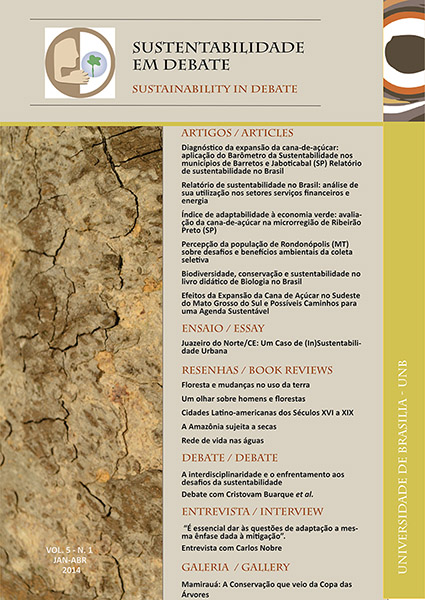Efeitos da Expansão da Cana de Açúcar no Sudeste do Mato Grosso do Sul e Possíveis Caminhos para uma Agenda Sustentável
DOI:
https://doi.org/10.18472/SustDeb.v5n1.2014.9982Palavras-chave:
Cana de Açúcar, Sudeste do Mato Grosso do Sul, Agenda de Desenvolvimento Sustentável, Plano de Zoneamento LocalResumo
O programa do Álcool brasileiro é apontado como uma estratégia para o desenvolvimento sustentável, no entanto, seus impactos negativos podem minimizar os seus benefícios. Nos últimos dez anos, a área de cana de açúcar aumentou de 105 mil ha para mais de 700 mil ha no estado do Mato Grasso do Sul, entretanto, pouco se sabe sobre os impactos causados nesta região do Brasil. O objetivo desse trabalho foi fazer uma avaliação dos impactos da cana no sudeste deste estado por meio de entrevistas, análise de relatórios e visitas a campo. A maior proteção de Áreas Legalmente Protegidas e aumento no número de empresas formalmente cadastradas estão entre os fatores positivos encontrados. Quanto aos impactos negativos, sobressaem os conflitos com Territórios Indígenas e problemas relacionados à saúde pública nas cidades envolvidas analisadas. Os resultados apontam para a necessidade do poder público criar e coordenar ações junto aos diversos setores com diretrizes claras focadas no desenvolvimento sustentável.
Downloads
Referências
Alterações na cobertura vegetal e no uso das terras entre 1972 e 2009 em área rural do Município de Guararapes, SP. In: Congresso Interinstitucional de Iniciação
Científica, 2011, Campinas. Anais... Campinas: Embrapa Monitoramento por Satélite,
2011. 8 p.
ALVES F. Por que morrem os cortadores de cana? Saúde e Sociedade, v.15, n. 3, p.
90-98. 2006.
ÁVILA, S. R. S. A.; ÁVILA, M. L.; ALTAFIN, I. G. Expansão Canavieira no Cerrado Goiano:
Crescimento Econômico é Desenvolvimento? Organizações Rurais e
Agroindustriais, v.13, n.3, p. 317-329, 2011.
BERNARD, H. R. Research Methods in Anthropology: Qualitative and Quantitative
Approaches . Fourth edition. Walnut Creek , CA : Altamira Press. 2006. 728 p.
BORRAS, S. M., FIG, D. & SUÁREZ, S. M. The politics of agrofuels and mega-land
and water deals: insights from the ProCana case, Mozambique. Rev. Afr. Polit. Econ.,
v. 38, p. 215”“234, 2011.
CANASAT ”“ INPE. Monitoramento da Cana-de-açúcar via imagens de satélite.
Disponível em http://www.dsr.inpe.br/laf/canasat/. Acessado em 10/12/2013
CBH-PARDO”“ Comitê de Bacia Hidrográfica do Rio Pardo. Plano de bacia da unidade
de gerenciamento de recursos hídricos do Rio Pardo. Cooperativa de Serviços e
Pesquisas Tecnológicas e Industriais e Instituto de Pesquisas Tecnológicas do Estado
de São Paulo. 2003.
CPT ”“ Comissão Pastoral da Terra. Conflitos no Campo 2011. Disponível em http://
www.cptnacional.org.br/index.php/noticias/12-conflitos/908-cpt-divulga-dadosparciais-
dos-conflitos-no-campo-brasil-de-janeiro-a-setembro-de-2011. Acessado
em 07/12/2012.
DEMIRBAS, A. Political, economic and environmental impacts of biofuels: A review.
Applied Energy, v. 86, p.108”“117, 2009.
DIAS de OLIVEIRA, M; VAUGHAM, B. E.; RYKIEL JR, E. J. R. Ethanol as Fuel: Energy,
Carbon Dioxide Balances, and Ecological Footprint. Bioscience, v. 55, p. 593”“602,
2005.
DUVENAGE, I., LANGSTON, C., STRINGER, L. C. & DUNSTAN, K. Grappling with
biofuels in Zimbabwe: depriving or sustaining societal and environmental integrity?
J. Clean. Prod., v. 42, p. 132”“140, 2013.
FACETTI, J. F. The Guarani Aquifer: A regional Environmental Service. In: GALINDOLEAL,
C. and CÂMARA, I. G. The Atlantic Forest of South America: biodiversity status,
threats, and Outlook. First Edition. Washington, USA: Island Press. 2003. 489 p.
FARGIONE, J.; HILL, J.; TILMAN D.; POLASKY, S.; HAWTHORNE P. Land Clearing and
the Biofuel Carbon Debt. Science, Vol. 319, p.1235-1238, 2008.
FERRAZ, S. T. Cidades saudáveis: uma urbanidade para 2000. Brasília, Paralelo 15,
1999. 102 p.
GOLDEMBERG, J. Ethanol for a sustainable energy future. Science, v. 315, p. 808”“
810 2007.
GOLDEMBERG, J.; COELHO, S.T.; GUARDABASSI, P. The sustainability of ethanol
production from sugarcane. Energy Policy, v. 36, p.2086-2097, 2008.
IBGE ”“ Instituto Brasileiro de Geografia e Estatística. Cadastral Central de Empresas.
Disponível em http://www.metadados.ibge.gov.br/detalhePesquisa.aspx?cod=CL.
Acessado 07/12/2012.
IBGE(a) ”“ Instituto Brasileiro de Geografia e Estatística. Mapas ”“ Solos. Disponível
em http://mapas.ibge.gov.br/en/tematicos/solos. Acessado em 23/06/2013.
IBGE(b) ”“ Instituto Brasileiro de Geografia e Estatística. O Brasil Indígena. Disponível
em http://www.funai.gov.br/projetos/Plano_editorial/Pdf/
encarte_censo_indigena_02%20B.pdf. Acessado 22/06/2013.
IBGE(c) ”“ Instituto Brasileiro de Geografia e Estatística. Produção Animal. Disponível
em http://seriesestatisticas.ibge.gov.br/
series.aspx?no=1&op=0&vcodigo=AGRO34&t=producao-vegetal. Acessado 24/06/
2013.
LAMBIN, E. F.; MEYFROIDT, P. Global land use change, economic globalization, and
the looming land scarcity. Proc. Natl. Acad. Sci. U. S. A, v. 108, p. 3465”“3472,
2011.
LAPOLA, D. M; SCHALDACH, R.; ALCAMO, J.; BONDEAU, A.; KOCH, J.; KOELKING, C.;
PRIESS, J. Indirect land-use changes can overcome carbon savings from biofuels in
Brazil. Proc. Natl. Acad. Sci. U. S. A., v. 107, n. 8, p. 3388”“3393, 2010.
LIMA, M.; SKUTSCH, M.; COSTA, G. M. Deforestation and the Social Impacts of Soy
for Biodiesel: Perspectives of farmers in the South Brazilian Amazon. Ecology and
Society, v.16, n. 4:24, 2011.
MDIC ”“ Ministério do Desenvolvimento, Indústria e Comércio Exterior. Conhecendo
o Brasil em Números ”“ Knowing Brazil in Numbers, Brasília. 2010
MDIC ”“ Ministério do Desenvolvimento, Indústria e Comércio Exterior. Conhecendo
o Brasil em Números ”“ Knowing Brazil in Numbers, Brasília. 2013
MORAES SILVA, M. A.; MARTINS, R. C. Produção de etanol e impactos sobre os
recursos hídricos. In: Plataforma BNDS. Impactos da Indústria Canavieira no Brasil.
Rio de Janeiro, BR: Ibase. 2008. 188 p.
MORAES, M. S.; PRIULI, R. M. A.; CHIARAVALLOTI, R. M. A saúde e o jovem migrante.
Cadernos de Saúde Coletiva, v. 20, p. 440”“447, 2012.
OLIVEIRA, A. M. S. . A Territorialização do Capital Agroindustrial Canavieiro e a
Nova Geografia do Trabalho Migrante no Brasil. In: Antonio Thomaz Júnior; Ana
Maria Soares de Oliveira; Marcelino Andrade Gonçalves. (Org.). Geografia e Trabalho
no Século XXI. 01ed. Presidente Prudente: Editorial Centelha, 2007, v. 03, p. 08-190.
PACCA S.; MOREIRA, J. R. Historical carbon budget of the brazilian ethanol program.
Energy Policy, v. 37, p. 4863-4873, 2009.
ROTTA , C. V. et al. Proposição de critérios para a construção de indicadores voltados
aos temas governança, saúde e bem-estar e coexistência em uma cidade global do
projeto “Cidades Inovadoras: Curitiba 2030”. Revista Brasileira de Planejamento
e Desenvolvimento, 2012; 1 (1): 99-113.
RUDORFF, B. F. et al. Studies on the Rapid Expansion of Sugarcane for Ethanol
Production in São Paulo State (Brazil) Unsing Landsata Data. Remote Sensing, v. 2,
n.4, p.1057-1076, 2010.
SANCHEZ, L. E. Avaliação de Impactos Ambientais: conceitos e métodos. São Paulo,
SP: Oficina de Textos. 2006. 496 p.
SCHARLEMANN, J. P. W.; LAURANCE, W. F. How Green Are Biofuels? Science, v.319,
n. 5859, p.43-44, 2008.
SOUZA, M. A. A Dinâmica Territorial do Agronegócio Canavieiro e o Zoneamento
Agroecológico da Cana-De-Açúcar: Notas Para Um Debate. Campo-Território:
revista de geografia agrária, v.5, n.10, p. 148-167, ago. 2010.
TERRY, A. Evaluating the Green Revolution after a decade: a Swaziland case study.
International Journal of Agricultural Sustainability, v. 10, p. 135”“149, 2012.
VILAS BOAS, S. W.; DIAS, E. C. Contribuição para a discussão sobre as políticas no
setor sucroalcooleiro e as repercussões sobre a saúde dos trabalhadores. In:
PLATAFORMA BNDES. Impactos da indústria canavieira no Brasil. Rio de Janeiro:
IBASE, 2009. p. 50-62.
ZOMMERS, Z., JOHNSON, P. J. & MACDONALD, D. W. Biofuels bonanza? Sugarcane
production and poverty in villages surrounding Budongo Forest, Uganda. J. East.
African Stud., v. 6, p.177”“195, 2012.
Downloads
Publicado
Como Citar
Edição
Seção
Licença
A submissão de trabalho(s) científico(s) original(is) pelos autores, na qualidade de titulares do direito de autor do(s) texto(s) enviado(s) ao periódico, nos termos da Lei 9.610/98, implica na cessão de direitos autorais de publicação impressa e/ou digital à Revista Sustentabilidade em Debate do(s) artigo(s) aprovado(s) para fins da publicação, em um único número da Revista, autorizando-se, ainda, que o(s) trabalho(s) científico(s) aprovado(s) seja(m) divulgado(s) gratuitamente, sem qualquer tipo de ressarcimento a título de direitos autorais, por meio do site da Revista, para fins de leitura, impressão e/ou download do arquivo do texto, a partir da data de aceitação para fins de publicação. Portanto, os autores ao procederem a submissão do(s) artigo(s) Revista, e, por conseguinte, a cessão gratuita dos direitos autorais relacionados ao trabalho científico enviado, têm plena ciência de que não serão remunerados pela publicação do(s) artigo(s) no periódico.
A Revista encontra-se licenciada sob uma Licença Creative Commons Atribuição-NãoComercial-SemDerivações (Proibição de Realização de Obras Derivadas) 3.0 Brasil, para fins de difusão do conhecimento científico, conforme indicado no sítio da publicação, que permite o compartilhamento do texto e o reconhecimento de sua autoria e publicação original nesta revista.
Os autores têm permissão para assumir contratos adicionais separadamente, para distribuição não-exclusiva dos trabalhos publicados na Revista Sustentabilidade em Debate (por exemplo, em um capítulo de livro), desde que seja assinalado que os textos foram originalmente publicados nesta revista e que seja mencionado o DOI correspondente. Os autores têm permissão e são estimulados a publicar e distribuir o seu texto online, após a publicação (por exemplo, em repositórios institucionais ou nas suas páginas pessoais).
Os autores declaram expressamente concordar com os termos da presente Declaração de Direito Autoral, que se aplicará a submissão caso seja publicada por esta Revista.






